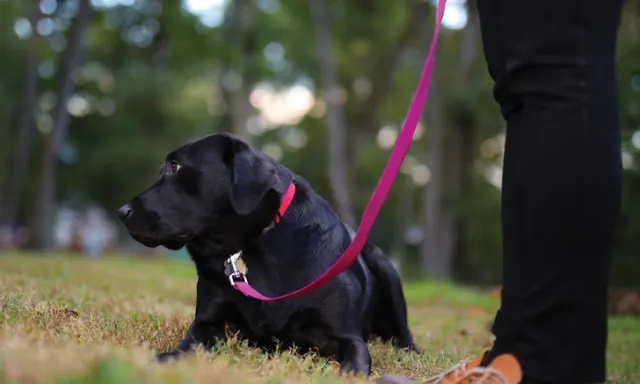Helping an Overweight Dog Lose Weight
Kara M. Burns, MS, MEd, LVT, VTS (Nutrition), Olathe, Kansas

S-O-A-P
Subjective
Presentation: Freddie, an 8-year-old, neutered Labrador retriever, is presented for lethargy and exercise intolerance of 3 weeks’ duration.
History: Six months earlier at his annual wellness examination, Freddie was classified as overweight. Increased exercise and monitoring of food intake was recommended; results and recommendations from earlier wellness examinations were similar.
The client reports Freddie’s pace on his walks has slowed and for the past 3 weeks he lies down after 5 minutes, unable to complete exercise. Appetite remains intact.
Medication & Social History: Vaccinations are current. Preventives for heartworm, fleas, and ticks are given monthly. No medications are being given. There is no recent travel history. There are 2 cats and 1 other Labrador retriever in the household.
Nutrition History: The patient is fed large-breed, senior dry food with no change in brand or diet since his last examination; 2 scoops (from a 56-oz fountain soda cup) are provided q8h. The patient also eats some cat food, 10 treats q24h, and some table food from children in the home. Water is offered ad libitum.
Objective
Remainder of the physical examination was unremarkable.
Assessment
Obesity is noted, with resulting difficulty in ambulation, increased respiratory rate, increased pulse rate, and poor haircoat. Sarcopenia, noted as mild muscle loss, is observed in the temporal skull region and bilateral scapula. Significant periodontal disease is also present.
Plan
The veterinarian advises an exercise regimen, makes a specific feeding recommendation using therapeutic weight-loss food, and recommends periodontal therapy after at least 3 progress examinations.
The veterinary nurse is empowered to educate the client on pet obesity and its risks while supporting, or reinforcing, the veterinarian’s recommendations. Progress examinations that will include weighing the patient, performing a BCS and MCS, pain evaluation, and discussion of the exercise and nutrition plan with the veterinary nurse are scheduled every 2 weeks.
The Takeaway
Diagnosis
Obesity and sarcopenia, secondary to age and limited mobility
The diagnosis of grade 2 periodontal disease is also documented. The veterinarian recommends beginning the weight management program before scheduling a professional dental cleaning, as the patient’s weight and affected respiratory system contribute to anesthetic risk.
Treatment
The veterinarian recommends a goal weight of 70 lbs (31.8 kg) and, once achieved, will reevaluate the patient to determine if further weight reduction is warranted.
Therapeutic weight-loss food: The recommended intake is 750 kcal/day (based on an estimated 70 lbs [(31.8 kg)] target body weight), including 75 kcal/day for treats.
Target body weight = 31.8 kg
Resting energy requirement4 (RER):
RER kcal/day = 70(BW)3/4* = 937.4 kcal
Daily energy requirement5 (DER):
DER = (RER × ____ weight loss factor) = 937.4 × 0.8 = 750 kcal/day
Treats are allowed at 10% of DER or 75 cals/day, leaving intake at 675 kcal/day for meals
*To calculate with a basic calculator, enter: (kg × kg × kg, √, √) × 70
(See Resources.)
Exercise regimen: The recommendation is to begin with 2-minute walks 5 times per day; after 7 days, walks should be increased to 3 minutes 5 times per day. Puzzle-feeding toys should be used for some portion of the caloric intake (ie, kibble).
Physical rehabilitation: A veterinary technician specialist (physical rehabilitation) should perform passive range of motion (PROM) and balance exercises with the patient at the practice and give the client additional physical therapy exercises to be continued at home.
Practical Considerations
The human–animal bond must be recognized. Clients should be educated on the benefits of weight loss, including the potential to extend a dog’s life.6 (See Client Communication.) Clients may also be encouraged to hear that exercising with a pet has been shown to increase the amount of exercise and weight loss for client and pet alike.7
Client Communication
Education, patience, and support are key to managing an overweight or obese patient. Managing patient weight is often a very frustrating undertaking for clients and veterinary teams; however, the health of the patient, including the decreased risk for diabetes mellitus, osteoarthritis, anesthetic complications, and respiratory issues, is paramount. The veterinary team must advocate for the patient.
General: Weight management programs are not one-size-fits-all.3 Offer clients suggestions on ways, without food, to reward or bond with their pet (ie, dogs—going for a leash walk, playing with toys, petting the dog, verbal praise, feeding puzzles; cats—interactive toys [eg, laser pointers, feathers on a pole], feeding puzzles).
Exercise: When exercise is restricted, PROM exercises help to improve range of motion and promote healthy joints and proprioception. Balance exercises contribute to increasing muscle mass and rebuilding core muscle strength.
Condition Scoring: Educate the team and the client to evaluate BCS regularly. (See Client Handout.) Ask the client to call with a weekly score that is documented in the medical record. Involving the client empowers him or her to be part of the pet’s treatment and weight management plan. Explaining why the BCS is necessary and how it aids weight monitoring, and having the owner do this at home, helps the owner accept and follow the veterinary team’s recommendation. The same attention should be devoted to MCS, and although the client can do this, the veterinary team should closely monitor MCS in follow-up examinations.
Feeding Instructions: Recommend the appropriate weight-loss food and calculate the initial feeding amount. Consistency in feeding is critical, including feeding only from a designated dish. Introduce the concept of using an 8-ounce measuring cup for feeding. Emphasize the total energy intake and that the patient should be fed only what is in the treatment plan. Encourage clients to feed other pets separately, if possible (eg, feeding cats in an up-or-away area).
Follow Up: Evaluate, adjust, communicate, and encourage on a consistent basis. Be sure to celebrate weight loss, be it 0.5 or 5 pounds.